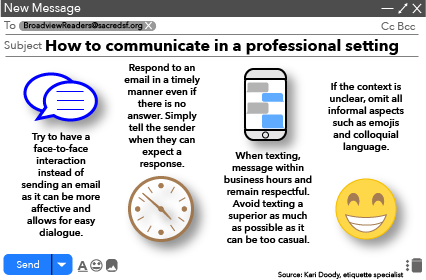Texting, emailing should keep recipient in mind
Online communication comes with do’s and don’ts

December 21, 2020
Although communicating via text or email with a teacher, dean, or college administrator can feel casual, messages sent electronically often require a higher level of formality.
“In order to stay professional, we have to conduct business using our best manners no matter how relaxed we may feel with a superior,” Kari Doody, founder of Courteous & Cool Etiquette School in Los Angeles, said. “In an email, one must be careful with their tone, punctuation and spelling because they may be scrutinized by the way their email comes across. They could lose credibility immediately if they send a poorly constructed, vague email.”
Using respectful language and good etiquette should be a priority in communicating professionally, according to Doody. Before sending an email, one should ask herself whether the email is necessary, if the tone is professional and if the message is concise.
“I expect an email from a student to have a tone that is not accusatory or aggressive, since it should show a sense of professionalism,” English teacher Mark Botti said. “I find that students will sometimes forget that they are talking to a teacher and not a friend when it is not face to face.”
Face-to-face interactions can be more meaningful than online communication as they allow for easy dialogue and follow-up questions, according to Doody, but before sending an email, authors should first ask themselves if they are avoiding in-person interaction and resorting to online communication because it may be “easier.”
“It is important to be clear and concise with emails and pinpoint certain topics to make it easier to read,” Doody said. “It is better to get straight to the point rather than making the email flowery because time is a priority in a business setting.”
Professional greetings such as “Dear,” “Good Morning” or “Hello” are usually necessary when addressing a teacher or other superior, however, if the email chain exceeds two emails, one should drop the greeting and go straight into the message, according to Doody. Clear and brief subject lines that summarize the email are also an integral part of online communication so the receiver is not left guessing.
Texting is an informal way of communication and is not recommended in most business settings when a phone call would suffice, according to Doody. Unless a boss is expecting a text, one should err on the side of caution when sending a text outside of business hours as it can be disrespectful to interfere with someone’s personal life.
“I rarely text my teachers just because I have never needed to,” Mogannam said. “Although, one time, I texted my art teacher because I had a question, but usually I try to communicate with my teachers during class or send an email.”
Sometimes neither a text or an email are appropriate, and direct interaction is a better way to communicate.
“Having a phone call or Zoom meeting with someone is much more effective than using email and text messaging,” Doody said. “If the conversation via email is over two paragraphs long, one should make a phone call as a long email can cause someone to lose interest.”
When using emoticons or abbreviations in a professional email, the context is critical when deciding whether or not it is appropriate to include them, according to Doody. If peers or superiors use colloquial language or emojis in the business environment, then it may be appropriate to use as well.
“Emailing teachers is probably the most formal way I communicate with anyone because you need to address them in a certain way,” Mogannam said. “Teachers are also people that students should respect more, so I make it more formal in that sense, too.”
A key part of communicating with a boss, teacher, or administrator is timeliness and quick responses, according to Doody. Even if the receiver has no answer, they should still respond and acknowledge the email instead of ignoring it.
“A big challenge that this generation faces is that they must remember that face-to-face communication is always better than screen to screen,” Doody said. “We have to be smart about online communication and remember that there are real people behind the screens.”









